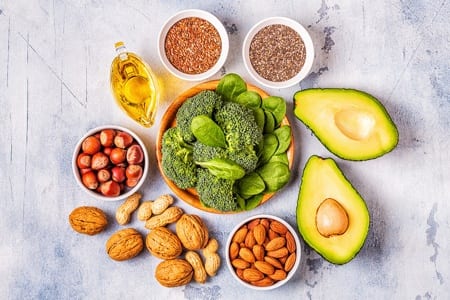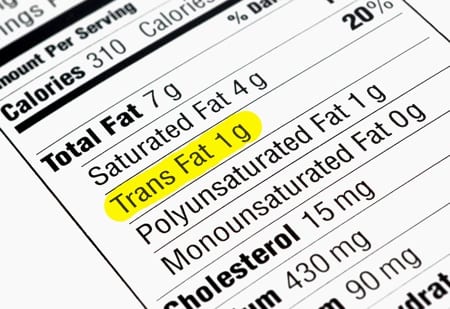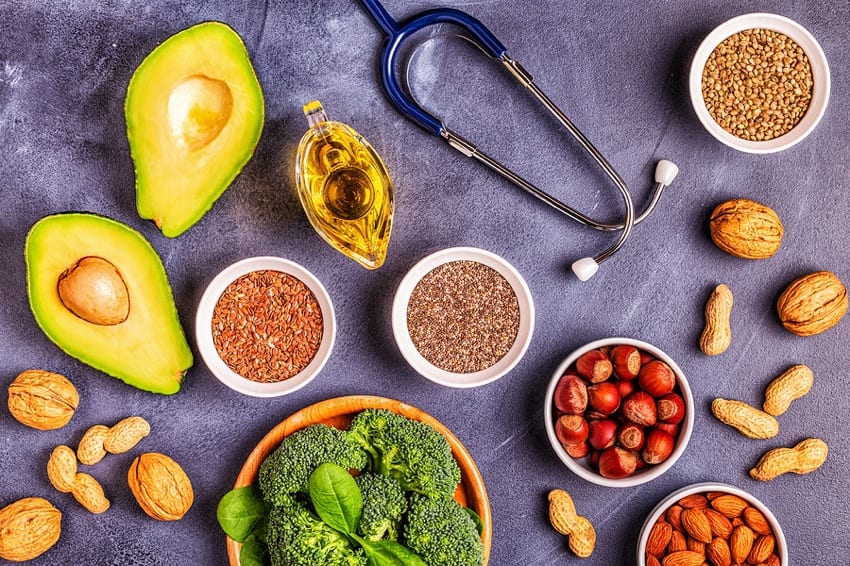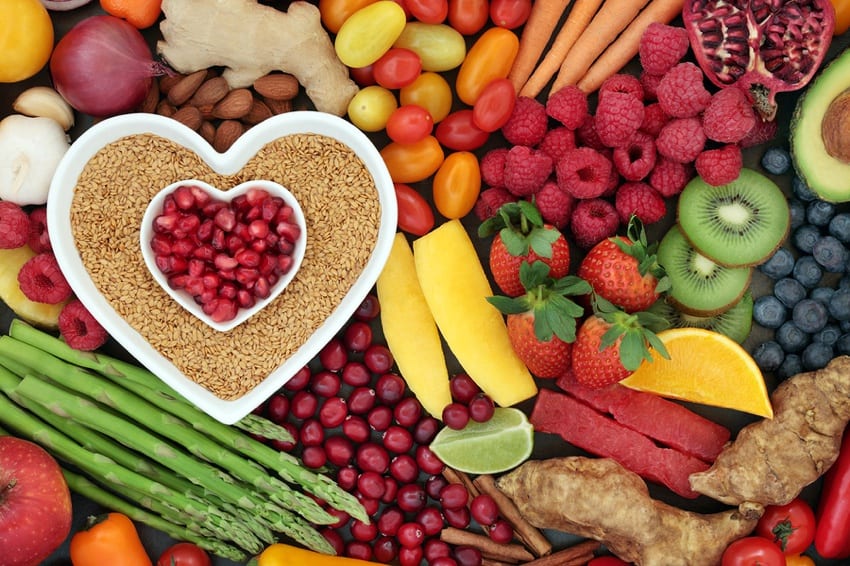 When examining the vegan credential of Omega-3 fatty acids, it is important to glance first at fat in general. Fat is one of the essential macronutrients and humans need some fat in their diet to be healthy. In the macronutrient world, fats are often seen as the bad guy, with protein and, to a lesser extent, carbohydrates seen as the good guys.
When examining the vegan credential of Omega-3 fatty acids, it is important to glance first at fat in general. Fat is one of the essential macronutrients and humans need some fat in their diet to be healthy. In the macronutrient world, fats are often seen as the bad guy, with protein and, to a lesser extent, carbohydrates seen as the good guys.
People may look to consume a lot of protein and the issue of good vegan protein sources is one we have looked at in depth on our site. In contrast, more often than not, people are seeking to reduce the amount of fat that they consume.
Good & Bad Fats
 Different people require different splits of fats, proteins and carbs, depending on their goals, lifestyle and bodies. However, in general it is thought people should obtain around 20%-35% of their total calories from fat. With a typical 2000 calorie per day diet, that equates to between 400 and 700 calories of fat.
Different people require different splits of fats, proteins and carbs, depending on their goals, lifestyle and bodies. However, in general it is thought people should obtain around 20%-35% of their total calories from fat. With a typical 2000 calorie per day diet, that equates to between 400 and 700 calories of fat.
The National Health service (NHS) suggests that eating less than 70g of fat (630 calories’ worth) on a 2000 calorie diet is best, so we would suggest somewhere between 400 and 630 calories per day from fat.
However, not all fats are created equally, far from it in fact; some fats are significantly healthier than others. For a long time fat was demonised in the media, but over the past 10-20 years the idea of “good” and “bad” fats has very much taken hold. Some people argue that the evidence that saturated fats are best avoided is erroneous, and advocates of some high fat diets claim there are studies backing up their stance.
Saturated Fats
This remains something of a contentious issue but the medical, nutritional and scientific communities generally agree that based on current evidence, the consumption of saturated fats should be limited. Of the higher limit of 70g of fat the NHS recommends we consume, a maximum of 20g should be saturated.
Unsaturated Fats
That means that the majority of the fat we consume should be unsaturated and this is (finally you may be saying!) where Omega-3s come in. Until relatively recently, most people with a basic understanding of nutrition were aware of the difference between saturated and unsaturated fats. However, over the past 20 years or so, more and more has become known about a division within unsaturated fats: that between polyunsaturated (PUFA) and monounsaturated (MUFA) fats.
Breakdown of Fat Composition
All fats actually contain a mixture of saturated, polyunsaturated and monounsaturated fats. However, the proportions of these can vary hugely. For example, butter and soft margarine have very similar fat contents per 100g (82.2g for the former, 81.7g for the latter) but their composition is very different.
| Item | Saturated | Polyunsaturated | Monounsaturated |
|---|---|---|---|
| Butter | 52.1g | 20.9g | 2.8g |
| Soft Margarine | 27.2g | 38.9g | 12.4g |
Trans Fats
There is a fourth type of fat – trans fats – with both butter and margarine containing a little of this too. We won’t look at this too much, nor what the chemical differences between these fats are other than to reiterate what we have said: in general, obtaining more of your fat requirements from unsaturated fats than saturated fats is good.
Omega-3: A Polyunsaturated Fat
Omega-3 is a specific type of polyunsaturated fat that is essential to humans. There are actually three types of fatty acids that fall into this group but it is α-linolenic acid (ALA) that is most important as the human body is able to synthesise the other two from this. Eicosapentaenoic acid (EPA) and docosahexaenoic acid (DHA) are classed as long-chain omega-3 fatty acids. They are usually found in fish oils, although chickens fed with EPA and DHA products also produce eggs with these acids in.
Omega-3 fats are essential for normal metabolic function and the NHS say that long-chain omega-3 fatty acids “can help to keep your heart healthy” and the British Dietetic Association (BDA) state that EPA and DHA “have the most direct health benefits”.
Whilst there is no doubt that the body does indeed need omega-3s, there are many claims about supposed benefits of them, in particular the long chain EPA and DHA type, that lack any hard scientific foundation. We’ll look at this in more detail but for now, let’s get onto those vegan sources of omega-3!
Vegan Omega-3 Sources

ALA is vital, as said, because the body cannot produce it and so it has to be obtained as part of the diet. The good news is that all of the best sources of ALA are actually 100% vegan. The name of the oil itself, linolenic, comes from the Greek for flax, which should give us a pretty good idea of what the best sources of ALA might be!
Flax, or linseed, is an excellent vegan way to get omega-3, but the king of seeds in this regard is actually chia. Kiwi seeds are also very high in ALA, as are lingonberries, hemp, walnuts and, perhaps more surprisingly, purslane and sea buckthorn. Rapeseed and soy beans are also good ways to get your ALA omega-3.
Vegan Food Sources of Omega-3
| Food | Serving | Grams of ALA per serving |
|---|---|---|
| Linseed Oil | 1 tablespoon | 7.26 |
| Chia Seeds | 28g | 5.06 |
| Walnuts | 28g | 2.57 |
| Linseeds | 1 tablespoon | 2.35 |
| Rapeseed Oil | 1 tablespoon | 1.28 |
| Edamame (frozen) | 60g | 0.28 |
| Kidney Beans | 60g | 0.10 |
| Whole Wheat Bread | 1 slice | 0.04 |
| Squash | 60g | 0.18 |
| Tofu (cooked) | 150g | 0.27-0.48 |
| Hemp Seeds | 1 tablespoon | 0.19 |
Small amounts of ALA are to be found in other foods too, including some vegan milks, but as you can see, adding a few particular foods to your diet should make it relatively easy to reach one’s required levels of this particular omega-3.
Switching to rapeseed oil for cooking and adding a few seeds or walnuts to your daily ritual would probably be enough, whilst edamame, tofu and squash are all commonly eaten by many vegans.
How Much Omega-3 Do We Need?
In the UK, there are no guidelines with regards the amount of omega-3 fats we should be eating and often there is confusion, with the different types of omega-3s treated as if they were one.
Rather unhelpfully, at least as far as vegetarians and vegans are concerned, when it comes to omega-3s, the NHS say that, “A healthy, balanced diet should include at least 2 portions of fish a week, including 1 of oily fish,” and that, “Most of us should have more fish in our diet, including more oily fish.”
Obviously, this is of no use whatsoever to vegans and those that don’t eat fish. So now we turn to Canada for our advice, with the Dieticians of Canada saying that we should aim for the following intake of ALA:
- Men 19+ – 1.6g per day
- Women 19+ – 1.1g per day
- Pregnant women 19+ – 1.4g per day
- Breastfeeding women 19+ – 1.3g per day
They also provide information on how much ALA is in various food items and the following table shows some of the best sources of ALA, with information also taken from the US National Institutes of Health.
Why Vegans Struggle with Omega-3
In theory, vegans should be easily able to eat enough ALA but the amount of the other two omega-3s, docosahexaenoic acid, or DHA, and EPA, or eicosapentaenoic acid, that can be produced from this are relatively small. In addition, although all respected health and nutrition organisations recommend consuming DHA and EPA, there is no recommended intake level for these because only ALA is classified as essential.
It is believed that less than 15% of the ALA we consume would be converted into DHA and EPA. Based on this the US Department of Health concludes that:
… consuming EPA and DHA directly from foods and/or dietary supplements is the only practical way to increase levels of these fatty acids in the body.
Consuming them “directly from foods” is not an option for vegans, with the only sources of these two omega-3 fats being fish and seafood. We will look at supplements shortly but there is another option for vegans.
The precise conversion of ALA into DHA and EPA will vary from person to person but obviously the more ALA one consumes, the better the body’s chance of creating the other two forms of omega-3s. The science behind this is inconclusive but the Vegan Society state that, “Some experts suggest that vegans should eat double the recommended amount of ALA.”
Given ALA in and of itself is a healthy and beneficial nutrient this seems fairly sound advice, as long as you stay within overall guidelines for total fat consumption.
Vegan Omega-3 Supplements
Taking omega-3 supplements would appear to be the best and easiest way for vegans to get the right balance of omega-3 fats into the diet. Although the two long chain omega-3 fats are predominantly found in fish and seafood, vegan-friendly supplements can be made from microalgae. As said, there is no official recommended intake level for these in the UK but the European Food Safety Authority (EFSA) recommend that adults consume 250 milligrams per day.
There are various vegan-friendly omega-3 supplements that would meet these guidelines and so, on the face of it, simply popping a vegan tablet a day is the quickest way to get your omega-3s.
But, Are They Actually Beneficial?
However, research suggests that such supplements may have little or no benefit. Cochrane – an independent body that seeks to “promote evidence-informed health decision-making by producing high-quality, relevant, accessible systematic reviews and other synthesized research evidence” – looked at 79 studies into omega-3s.
In July 2018, they published their findings, having assessed all the results of the 79 studies that included a combined total of well over 100,000 people. Cochrane look at the quality of the various studies and they deemed 25 to be “highly trustworthy because they were well designed and conducted”.
Cochrane concluded that:
The review provides good evidence that taking long-chain omega 3 (fish oil, EPA or DHA) supplements does not benefit heart health or reduce our risk of stroke or death from any cause. The most trustworthy studies consistently showed little or no effect of long-chain omega 3 fats on cardiovascular health. On the other hand, while oily fish is a healthy food, it is unclear from the small number of trials whether eating more oily fish is protective of our hearts.
With regards to ALA they said that:
This systematic review did find moderate evidence that ALA, found in plant oils (such as rapeseed or canola oil) and nuts (particularly walnuts) may be slightly protective of some diseases of the heart and circulation. However, the effect is very small, 143 people would need to increase their ALA intake to prevent one person developing arrhythmia. One thousand people would need to increase their ALA intake to prevent one person dying of coronary heart disease or experiencing a cardiovascular event. ALA is an essential fatty acid, an important part of a balanced diet, and increasing intakes may be slightly beneficial for prevention or treatment of cardiovascular disease.
Where Do Omega-6 Fats Fit In?

Omega-6 fats are also polyunsaturated fatty acids and the key one from a nutritional point of view is linoleic acid (LA). LA, like ALA, is an essential fatty acid, essential because the body cannot make them itself but needs them for optimal health. LA, like ALA, was discovered in the 1920s and initially the two fats were called vitamin F. Further studies that decade suggested they were better classed as fats than vitamins though.
Omega-6 fats are not something that people in the developed world suffer a lack of and in fact the opposite is more likely to be the case. It is thought that humans evolved eating roughly the same amounts of omega-3 and omega-6, or even more of the latter. However, most people now eat 10 to 20 times more omega-6 than they do omega-3.
It is thought that trying to eat a more balanced ratio of these two essential fatty acids may be beneficial. However, the solid evidence around this concept is limited and there is certainly no known ideal ratio.
Omega-6 Content in Food
| Food | Mg of omega-6 per 100g |
|---|---|
| Almonds | 12065 |
| Pecans | 20630 |
| Walnuts | 38092 |
| Sesame Seeds | 21372 |
| Poppy Seeds | 28291 |
| Peanuts | 15691 |
| Tofu | 2380 |
| Chickpeas | 1113 |
| Chia Seeds | 5785 |
Omega-6 fats are also found in a wide range of vegetables, grains and legumes in lower levels but many people get much of their omega-6 from fats and oils. Those who eat fish and meat also get a lot from those animal products and so both vegans and non-vegans are almost certainly getting enough linoleic acid in their diet.
How Much Omega-6 Do We Need?
The British Nutrition Foundation recommend that at least 1% of our overall energy intake should come from omega-6 fats. Based on information from 2008-2011, people are getting more than 5%. With lots of good sources of omega-6 being vegan friendly, we think it is safe to say that most vegans are probably getting sufficient levels of this essential nutrient.
As said, the more likely scenario is that we are actually consuming too much omega-6 and not enough omega-3. Lots and lots of studies are taking place on both of these separately and also in terms of the ratio between them. A huge range of possible health benefits are touted for both, as well as for an improved ratio of 3 to 6.
The Vegan Society claim that, “if you eat a lot of LA, your body may convert less ALA into EPA and DHA, reducing the amount of omega-3 fat in your blood”. However, we would stress their use of the word “may” and as with much in the discussion of omega-3 and omega-6, at the present time, there is no really solid evidence to support this.
Omega 3 & Omega 6 Conclusion

If you’ve found this article hugely confusing and not overly helpful then we apologise but that is the nature of some aspects of nutrition! The fact of the matter is that whilst lots of shops and sites push the benefits of these essential fatty acids as panaceas for a huge range of health issues, the facts are far muddier.
In time we may well uncover the full truth about how much of each nutrient is needed and how they interact with each other and how all this fits in with various diseases and illnesses. However, that time is a long way off and for now it is best to stick only to what we know.
Whilst respected and authoritative bodies such as the NHS claim we should eat more oily fish, much of their benefit is simply their overall health profile as opposed to the specific types of omega-3 fat they offer. The NHS claim that oily fish contains “long-chain omega-3 fatty acids, which can help to keep your heart healthy” but the reality is that the evidence is better for ALA (non-fish omega-3) with regards heart health.
A Lack of Quality Evidence
Wikipedia is an oft-maligned resource but in fact its accuracy and reliability has improved a lot since its earliest days. Whilst we would still advise double-checking information found there, we feel its summation of the benefits of omega-3 for health is very accurate. In short, there is little reliable evidence linking omega-3 to significantly improved health outcomes.
In some ways, this is excellent news for vegans who need not be overly worried about a diet that does not include any oily fish. As we have said when looking at other areas of nutrition, whilst sensationalist and low quality publications get clicks and shares by touting superfoods and mythical silver bullets, the science is rather less exciting.
Being overly worried about micronutrients is probably counterproductive given the lack of quality evidence currently available. The stress caused by worrying about what you eat is probably more damaging than the supposed lack or excess of a given nutrient.
What we do know is that eating a wide range of fruits, veg, nuts, grains and seeds is healthy. We also know that a diet high in fibre is certainly one to aim for. Whilst some may dispute it, the evidence that saturated fats should be limited is also strong. All of these health goals are highly compatible with a vegan diet.
So, rather than worry about the contents of a cod’s liver, keep being kind, keep being vegan and have a nice multi-coloured bowl of plant-based goodness!